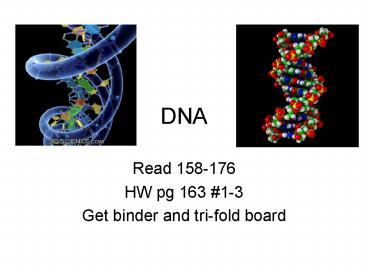DNA PowerPoint PPT Presentation
1 / 12
Title: DNA
1
DNA
- Read 158-176
- HW pg 163 1-3
- Get binder and tri-fold board
2
Announcements
- Next test is December 15/16 (Monday and Tuesday
before break) - Test covers material from Mitosis through DNA
- Science Fair is due NEXT WEEK
- Next week all class time will be science fair time
3
History
- Before we move into DNA, its important to track
the historical discoveries along the way. - 1866 Mendel observes inheritance using pea plants
- 1868 Friedrich Miescher extracts DNA from pus
- 1903 Walter Sutton and Theodor Boveri develop the
theory of chromosomal inheritance - 1910 Thomas Morgan verifies chromosomal using
fruit flies - 1928 Fredrick Griffith studies genetics in mice
- 1944 Oswald Avery indicates DNA is genetic
material
4
History part 2
- 1952 Maurice Wilkins and Rosalind Franklin
photograph DNA - 1952 Alfred Hershey and Martha Chase confirm DNA
as genetic material - 1953 James Watson and Francis Crick model DNA
5
So?
- The big names to know (and what theyre known
for) - Mendel
- Wilkins and Franklin
- Hershey and Chase
- Watson and Crick
6
DNA structure
- DNA is made of nucleotides
- Made of 3 components
- A 5-carbon sugar (deoxyribose)
- A phosphate group
- A nitrogen base (4 options)
7
The 4 bases
- Adenine (A)
- Guanine (G)
- Cytosine (C)
- Thymine (T)
- Adenine and Guanine are Purines
- Cytosine and Thymine are Pyrimidines
8
The twisted ladder
- Soon after Wilkins and Franklin took a snapshot
of DNA, Watson and Crick realized it was far too
thick to be a single strand. - Watson and Crick modeled DNA as a double helix,
two strands wound around each other.
9
DNA Structure
- Known also as a twisted ladder due to its
appearance. - Each rung/step is the matching of a purine to a
pyrimidine - The backbone is made of the carbon and phosphate
regions of the nucleotides - AT form 2 hydrogen bonds
- GC form 3 hydrogen bonds
10
Replication
- DNA replication occurs in much the same way as
unzipping a zipper. - Enzymes split the DNA into 2 strands
- Free-floating nucleotides bind to their
complementary base - Backbones form on the new side
- Replication happens in opposite directions on
each strand (imagine the left side forms
travelling up, while the right side forms
travelling down)
11
Check Questions
- What are the 3 common parts of a nucleotide?
- What are the 4 nitrogen bases?
- Are there always an equal number of cytosine to
guanine?
12
Science Fair Details
- What goes in your ½ in to 1 in binder
- Research Paper (updated if necessary)
- Experimental Design
- Question
- Purpose
- Hypothesis
- Materials
- Procedure
- Graphs and Data Tables
- Data Analysis
- What does the data show? Interpret your data
- Conclusion
- How do your findings relate to your hypothesis?
- What errors did you have in your experiment?
- How could you expand on your project?

